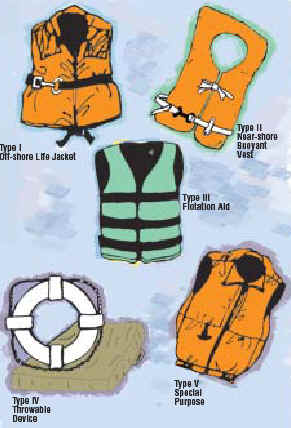Most adults need an extra 7 to 12 pounds of buoyancy
to keep their heads above water. A PFD can provide that “extra lift”
to keep you afloat until help comes. Your weight isn’t the only
factor in how much “extra lift” you need. A person’s body fat, lung
size, clothing and the water conditions also play an important
part.
There are different
types and styles of PFDs. When selecting a PFD, read the label
to make sure it is for a person your size and weight. You also need
to consider the type of boating and the area in which you will be
boating. Many boaters object to wearing traditional life jackets
because they can be uncomfortable and hot. However, the new
inflatable PFDs, which were recently approved by the U.S. Coast
Guard, are lightweight, comfortable, and provide the wearer with
greater mobility. Manual inflatables are certified as Type III. They
require the wearer to pull an inflatable tab in order to work, so
they will not be of any help to an unconscious wearer. Automatic
inflatables will inflate within 5 seconds of immersion and also have
a manual inflation tab. Both types have backup oral inflation tubes.
The automatics are certified as Type V and must be worn in order to
be legally counted. Inflatables cannot be used by persons under 16
years of age, persons under 90 pounds, or for high speed water
sports such as water-skiing or Personal Watercraft operation or
riding. As with all life jackets, be sure to read the label
carefully to be certain that you are using it correctly.

PFD Facts - Life Jackets
Float....You Don’t
-
Type I and Type II tend to turn an unconscious
person face up with Type I providing the most buoyancy. TYPE V may
only be used for its special designated purpose. They must be worn
to count.
-
All PFDs must be United States Coast Guard
approved and in good serviceable condition.
-
All PFDs must be readily accessible. Better yet-wear
yours!
-
Buy the right size. A PFD should not be able to be
pulled up past the ears.
-
Buy the right kind - will depend on the type of
boating.
-
Ski belts are not legal PFDs in Connecticut.
-
85% of fatalities could be avoided if people wore
their PFDs.
Special PFD Requirements:
Connecticut
During the period from October 1st through May 30th,
all persons on board a canoe shall wear a Type I, II, III or
V, U.S. Coast Guard approved personal flotation device and no
operator or paddler shall allow any person to be aboard who is not
wearing such a device.
The operator or owner of any vessel being used for
recreational
purposes shall require any child under twelve
years of age who is aboard such vessel to wear a personal
flotation device while such vessel is underway unless the child is
below deck or in an enclosed cabin.
Trying Your PFD
Try on your PFD to see if it fits comfortably snug.
Then test it in
shallow water to see how it handles.
Tilt your head back. The PFD should keep your chin
above water so you can breathe easily.
Caring for Your
PFD
Follow these points to be sure that your PFD stays in
good condition:
-
If your PFD doesn’t fit, get one that does.
-
Don’t put heavy objects on your PFD or use it for a
kneeling pad or boat fender. PFDs lose buoyancy when crushed.
-
Let your PFD drip dry thoroughly before putting it
away. Always stow it in a well-ventilated place.
-
Don’t leave your PFD on board for long periods of
time when the boat is not in use.
-
Never dry your PFD on any direct heat source.
-
Put your name on your PFD if you’re the only wearer.
-
Practice throwing your Type IV PFD. Cushions throw
best underhand.
-
Service inflatables regularly as required.